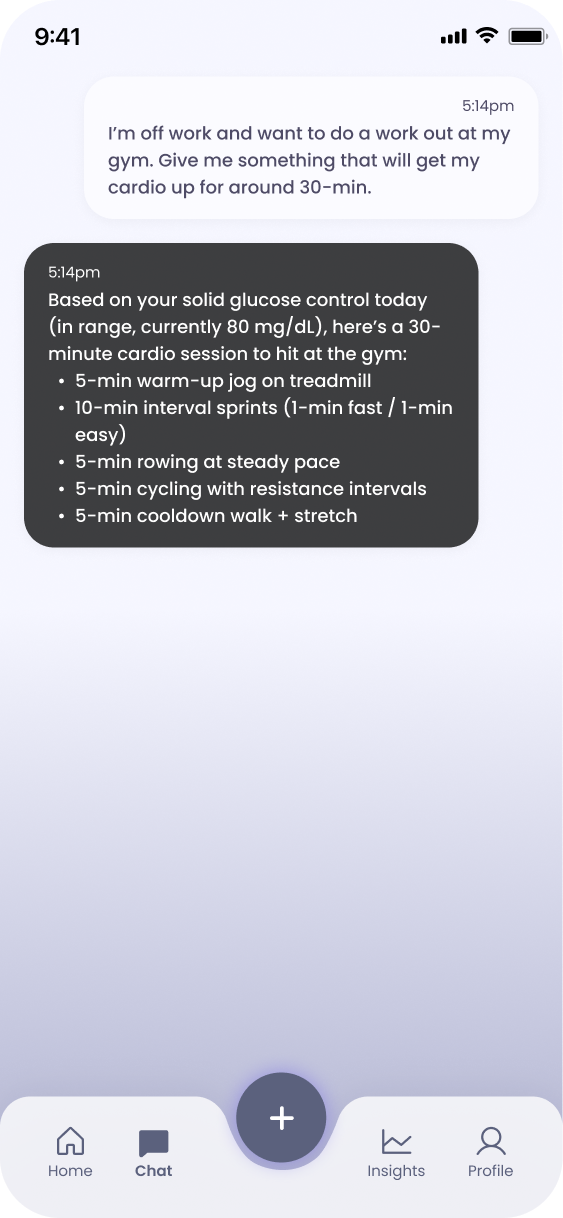wellness ai
An AI-powered wellness assistant app concept helping early-stage type 2 diabetics—millions in the U.S.—build healthier habits through nutrition and exercise.
ROLE:
Mobile app design
Due to NDA restrictions, this project is presented as a concept case study. The scenarios are anonymized, but the design approach and outcomes are grounded in real client work.
context
Managing early-stage type 2 diabetes is about more than just tracking glucose—it’s about sustainable lifestyle shifts. Over 38 million Americans currently live with diabetes, roughly 90% of which are type 2 cases, and many more are in the pre-diabetes stage. This represents a growing demographic in the millions, and one that urgently needs accessible, empathetic digital support.
the challenge
Raw glucose readings alone can feel clinical and overwhelming to someone just starting their health journey. Many early-stage type 2 diabetics grapple with confusion around…
Which foods impact their numbers and how
How much movement actually helps
How sleep and stress affect their glucose control
Finding a balance between healthy advice and feeling judged
the opportunity
What if a single assistant could integrate these factors and provide a daily wellness score — empowering users with clear, actionable insights?
my role
I led the product design exploration, from research synthesis and behavioral journey mapping to wireframes and hi-fi prototypes. I collaborated with clinical advisors and behavioral health experts to make sure the guidance felt realistic, empathetic, and safe.
research & insights
-
Nutrition confusion
“I know I need to eat better—but what, exactly?”
This was where most folks felt stuck, especially being thrown into diagnosis with no lifeline.
-
Exercise misperception
Many believe healthy habits require intense workouts.
In reality, small changes in daily habits - such as a post-meal walk for 15-minutes - helps to stabilize spikes significantly.
-
Sleep/stress blind spots
Users often don’t realize how poor sleep or stress spikes their glucose.
Many contributing factors go into an overall A1C - not just diet and exercise. Research shows that many don’t know that early on.
-
Empowerment over judgment
Feedback framed as encouragement is more effective than correction.
This is true no matter where you are in your diabetes journey.
User Journey Map
I mapped the end-to-end experience across Awareness, Consideration, Acquisition, Service, and Loyalty to highlight user goals, pain points, and emotions. This helped to identify friction—like confusing onboarding or generic recommendations—and uncover opportunities to simplify flows, deliver personalized guidance, and boost long-term engagement.
key design elements
The concept: an AI-guided wellness companion that…
Personalizes feedback based on biosensor data—showing how meals and movement affect glucose.
Highlights patterns, such as post-lunch spikes, with visual clarity.
Suggests small, achievable wins—like swapping an ingredient, walking after meals, or brief breathing exercises.
Provides real-time help when you need it most, with the power of AI.
Here’s a one-pager summarizing the Wellness AI app ⬇️

Prototype
In this prototype, you can explore a possible “day in the life” of a user interacting with the Wellness AI app. They go through onboarding and navigate key sections like Home, Chat, and Insights to track progress and receive guidance.
Outcomes & reflection
As a concept exploration, the goal wasn’t live metrics—it was validating direction.
Users welcomed holistic insight—not just numbers.
Positive nudges > guilt or micromanagement.
The AI framework made the assistant feel approachable, adaptive, and trustworthy.
This project reaffirmed that wellness tech should encourage, not judge. Real health happens when people feel supported, empowered, and capable—not overwhelmed. Designing for early-stage type 2 diabetics meant meeting people where they are—with empathy, clarity, and simplicity as guiding lights.





